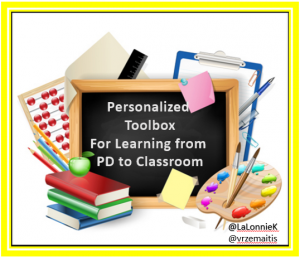
**Blog Buddy Post**
Thoughts by LaLonnie King (Texas) @Lalonniek
Valerie Zemaitis (Indiana) @vrzemaitis

Katie Martin states in #IMMOOC Season 2, Live Session 4 that in order to be innovative the first step is to decide what you want your students to know, understand and be able to do. Once there is a shared vision of the needs and wants, you find the tools to achieve those goals. Then we need to look for evidence of those tools making an impact. She said this evidence can be found if we use George Couros’s 8 Characteristics of an Innovative Classroom. We, as teachers and administrators, need to have these characteristics modeled for us, if innovation is expected of us.
The challenge of this blog is to focus on how these characteristics are being used in our professional development.
We can agree that we have had a lot of professional learning as educators. What turns out is we have been given a lot of tools to use. George confirms this belief when he stated in IMMOOC Live Session 4 Season 2 that it is called the “Teacher Platter”, rather than the “Teacher Plate”. Every teacher has that kitchen drawer or tool kit with so many tools we forget what it buried in there. Do you remember the excitement when you first gained that new tool and how to utilize it with the students? We use it for awhile and put it down when the next “tool” is shared with us. We now have so many tools that our tool boxes are unorganized and overflowing. Teachers are forgetting some of the best tools that were just shared with them because of another new tool. Educators have so many tools and resources, but they always want the one “tool” that will have the greatest impact; an impact on our students, in our kitchen, or when we make a repair. It is time to go on an “innovation diet” and clean out our drawers so we can be effective at using the few that have the biggest impact.
Wouldn’t it be ideal if professional learning and development involved one or more of these characteristics from the 8 Characteristics of an Innovative Classroom? Training sessions that are innovative by nature will have the greatest impact on us, and in the end positive outcomes for our students! How would professional learning look if these characteristics are used? What we need is a shared document that we can continually add to and take ideas from as we choose tools for our district, campus, or classroom.
The chart below has a few ideas that are being used in our schools in Texas and Indiana, or include ideas that we would like to see being used in school. Each item is a starting point that can be developed and created to fit your specific needs.
|
VOICE |
CHOICE | TIME FOR REFLECTION |
OPPORTUNITIES FOR INNOVATION |
| |
|||
|
|
|
|
|
CRITICAL THINKERS |
PROBLEM SOLVERS/FINDERS | SELF ASSESSMENT |
CONNECTED LEARNING |
|
|
|
|
The key to learning, whether adults or children, is that the tools we use need to be chosen carefully so the impact matches the expectation set for those specific tools. We do not necessarily have to use the same tool to get the job done. Learners of all ages should be motivated through investigation and have the chance to create questions while being challenged. The environment should be a place where the learners can take risks and try new things. Teachers and students who are able to embrace this culture will be more positive and more empowered to make the learning their own which is the true intent of every teacher when they bring a tool to the classroom.